Looking for cartoons drawn by soldiers in the FWW
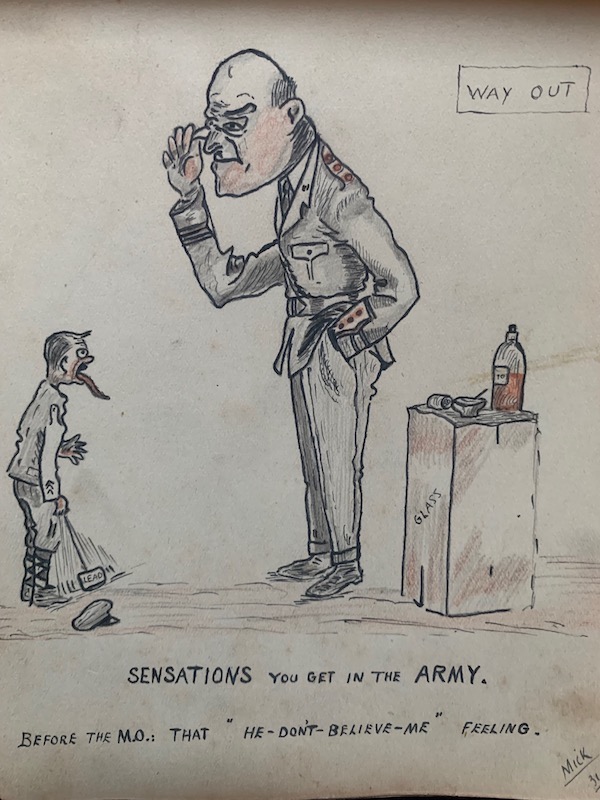
Updated May 22
Thank you to all those who have got in touch so far. This page has been updated both in the dissertation scope and with the addition of an FAQ.
Dissertation Research
A survey of British First World War cartoons, drawn by soldiers themselves in trench periodicals, journals, autograph books or, as in the case of Brigadier General Howard Tew, on the back on his signal pad. The survey will examine the role of humour both as a psychological coping mechanism and as a way of making sense of the soldiers’ world. In addition, by treating cartoons as a historical source, rather than just to illustrate a point, the survey also aims to add further insight into considerations of gender, popular culture, and language.
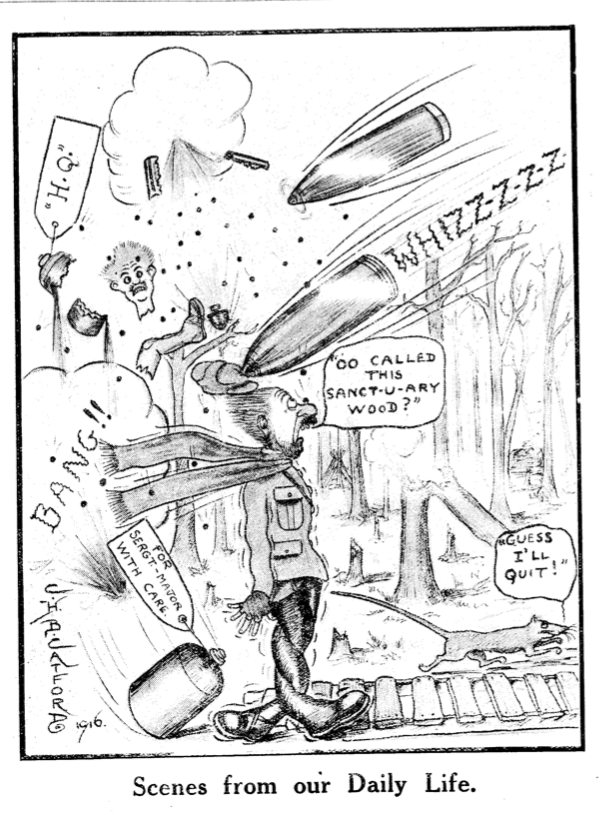
From the fields of Flanders to the marshes of Mesopotamia, the industrialised nature of the First World War meant the soldier, far from home, had to survive and mentally process a landscape which was defined by extreme emotions, where exhaustion and boredom were just as dangerous as fear. Soldiers developed many ways to make sense of this alien world, such as through the anglicisation of place names (Ypres became ‘Wipers’), naming trenches after streets from home, and bringing civilian pastimes to the trenches, in what historian Alexander Watson has called ‘Front Line Gardening’, to bring both familiarity, security, and a level of normality to their lives.1
Humour played a vital part in this process, and while this space could be filled with how modern psychiatric studies have proven the links between humour in reducing threat-induced anxiety, the words of Anthony Bluett, a gunner with the Egyptian Expedition Force, sums up why light relief was important to the soldiers on the front line:
For there were days when one hated the sight of one's best friend, when the mere sameness of everything drove one almost to distraction, and when the heat and the little exasperations of our daily work kept the temper constantly on edge. One had to laugh at something; it was the only way to keep sane. So, if there should occasionally creep into these pages a somewhat frivolous tone, I crave your indulgence, for it was truly the atmosphere in which we, in common with other lonely outposts, lived and worked. It was fatal to take life too seriously; wherefore, as we had little else to laugh at, we laughed at ourselves.2
Cartoonists, such as Bairnsfather and Robinson, along with political and propaganda cartoons produced by Punch and Raemaekers, have been well studied to date, but relatively little has been done on cartoons produced by the rank and file. A key difference is that cartoons produced professionally go through drafts and, especially in the case of propaganda, are fine-tuned for their audience. The soldiers' cartoons, on the other hand, are much rawer, and in most cases their audiences were fellow soldiers.
The survey will take a methodological approach, similar to how political and propaganda cartoons have been analysed, and will take both a statistical and sentiment-based approach, looking for common themes. By treating cartoons as historical sources, rather than as tools to illustrate a point, this should provide an insight not only into how soldiers saw and processed their world, but also into gender, popular culture and language.
In his seminal book on morale, Troop Morale and Popular Culture in the British and Dominion Armies 1914-1918, J.G. Fuller stated that the unique humour shown in the trenches was a 'war winning quality'.3 More recent work by E. Madigan and A. Mayhew has shown that there is a strong psychological case to be made in this regard and the proposed research will add further evidence.4
I need your help

I need help in identifying sources; if you are a historian or researcher and have noticed soldiers' cartoons in an archive or publication then please get in touch to let me know where. In the same vein, if you an archivist and have cartoons in your collection then please contact me.
If you collect FWW memorabilia, I would be most grateful if you would be willing to share any examples you may have — mobile phone photos of the material are absolutely fine — and I am happy, if there are copyright issues, to sign any NDAs in the process. Likewise, if you are not a collector but have any old family heirlooms that may be relevant, and you would be willing to share, then please do get in contact. Finally, if you have any related 'orphaned ephemera' collecting dust, which you would like to donate, I am more than happy to make a donation to a charity and cover postage costs.
FAQ
Are you only interested in soldiers' cartoons — what about sailors, airman, etc?
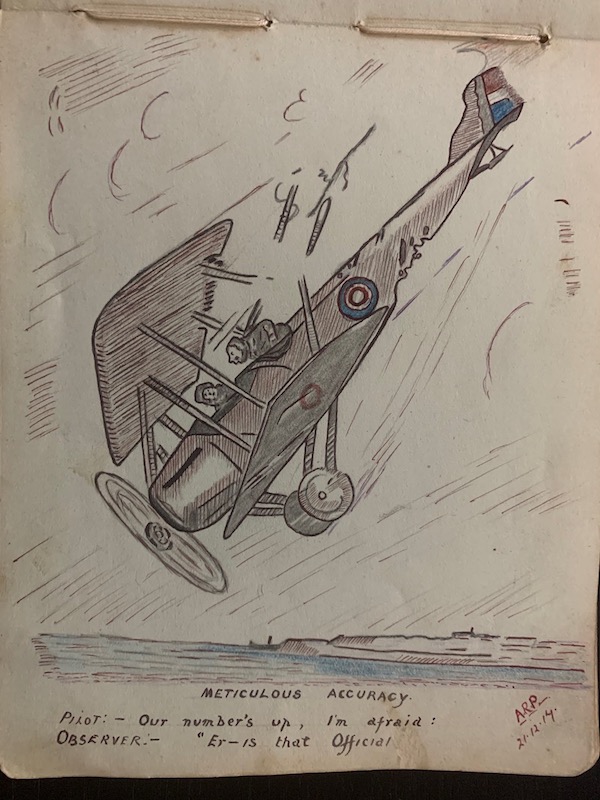
The primary focus is on soldiers because, to understand their cartoons, I need to understand their world and in the scope of a masters dissertation, I only have the resources to focus on one. I am however, interested in 'taking a glance' at cartoons produced in other arms, as well as by nurses, ambulance drivers, government staff, etc. as this gives a frame to contextualise the cartoons.
Are you only interested in British cartoons?
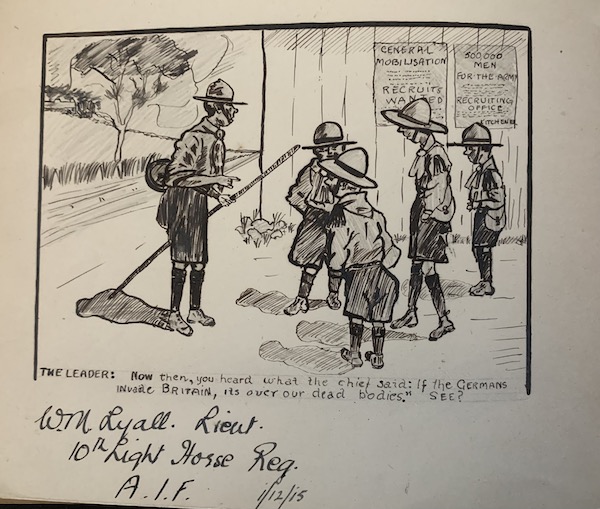
Yes, part of the process in analysing the cartoons involves 'stripping out' popular culture —from early research, this is involving becoming familiar with music hall songs, adverts, and propaganda. As fascinating as a comparison between other countries would be, that would need the timescale and resources of a PhD. Please note, however, that Britain at the time I'm looking at refers to the Empire, so I am interested in cartoons from Canadian, Australian, New Zealand, and other dominion troops.
Are you just interested in cartoons from August 1914 to November 1918?
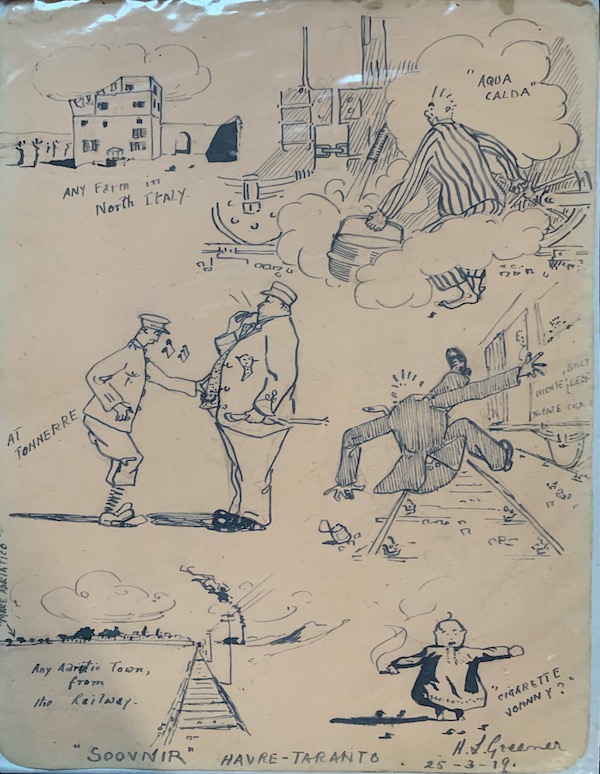
No, demobilisation went on well into 1922 and in addition there were many hospitals and convalescent homes for serviceman throughout the 1920s. Without wanting to bias my research, later cartoons are of interest as there is a clear 'shift' in tone and subject.
I have some drawings, but they are, to put it politely, artistically challenged.

I have a cartoon, but it is not politically, correct.
From a generation that would have grown up in an unashamedly imperialistic and patriotic period, there is naturally material from the time which through modern eyes is plain racist. They are still, however, evidence and of interest — they will be treated in the context of their time. Similarly, this was a time before 'no means no' and very different ideas on gender relations; again, cartoons of this ilk will be treated as evidence and in the context of their time. For this survey to be meaningful it must cover all facets of society.
I have some sketches, dated during the war and definitely by a soldier, but I can't see what they have to do with the war.
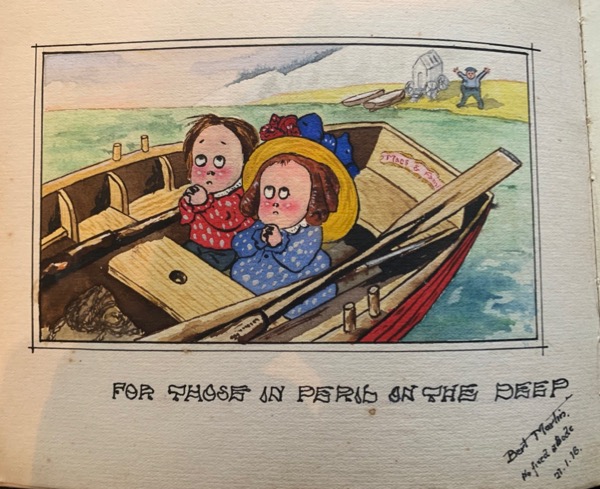
This goes back to the point above about popular culture, as the meaning might not be obvious on first glance and may be important when considered in context. For example, referring indirectly to a person of the day or an event. Take a second look at the cartoon above, and consider that in the month before it was drawn 140,000 tonnes of merchant shipping was lost to U-boats.
I have what seems to be a book full of copies of Punch, postcards, and Bairnsfather cartoons — any interest?
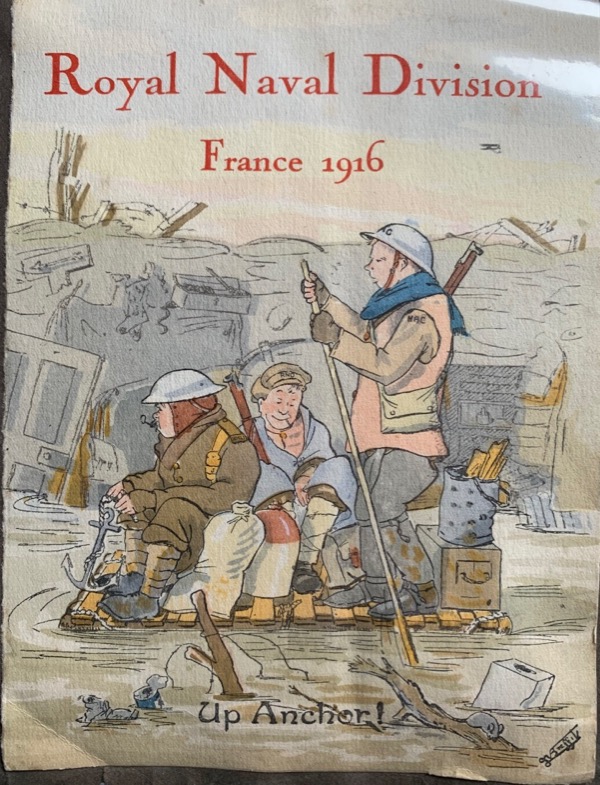
Continuing with popular culture, yes as this gives an indication of what was popular, and in the case of propaganda what could be considered successful. Again, not wishing to bias my research, I have come across quite a few examples of popular character such as 'Old Bill' being used in the soldiers' own creations.
I run a local history group, would you be willing to write something for our website or give a talk if you use our material?
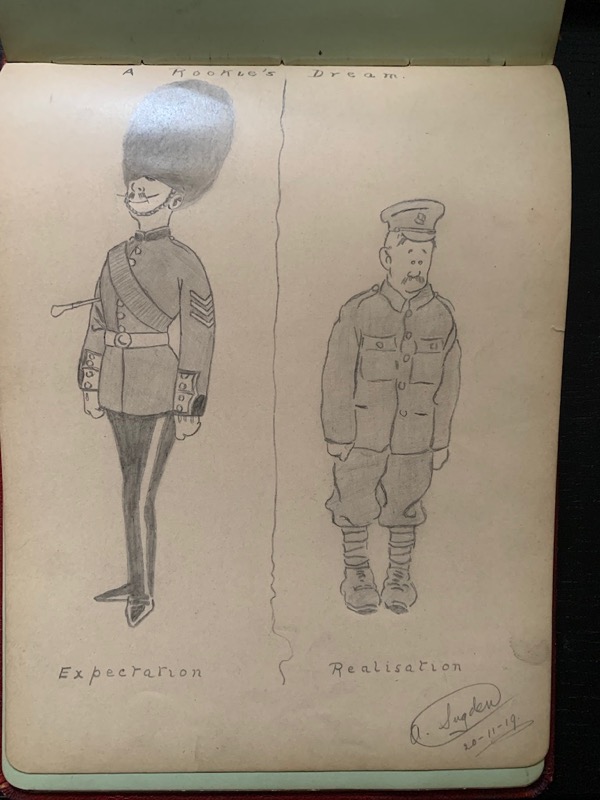
Yes, absolutely it would be a pleasure. For practical reasons it would have to be after completion of the dissertation, which will be in January 2023.
Will I be able to read your dissertation when it's done?
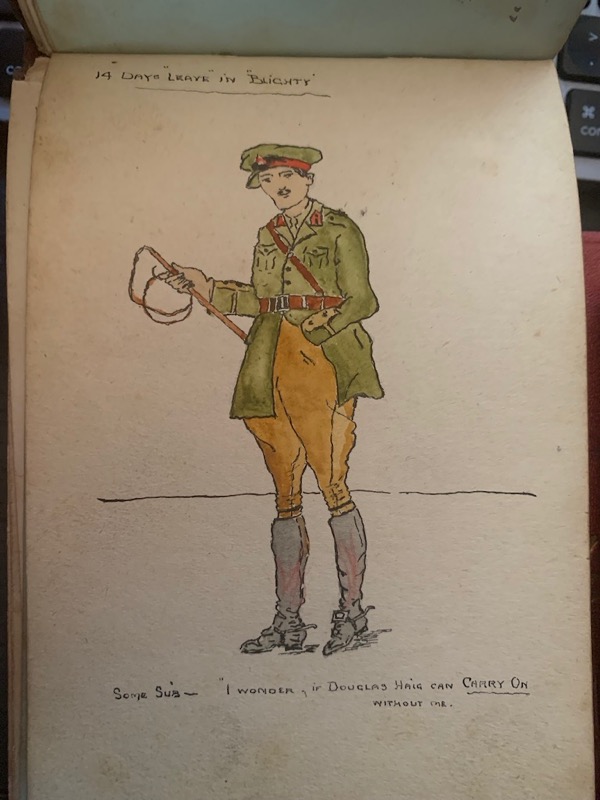
Yes, I am also planning to add some articles — especially around methodology and examples on this website.
I am interested in this whole idea of cartoons as historical sources, where can I find out more?
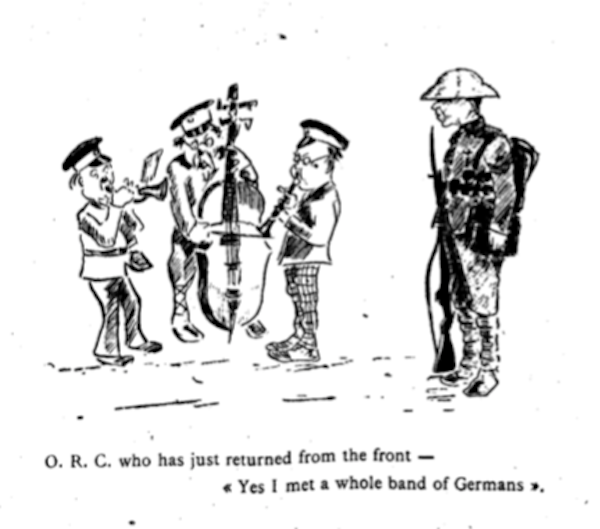
As a start, in terms of understanding cartoons and comics, I would recommend Scott McCloud's Understanding Comics: The Invisible Art (New York: Harper Collins, 1993) For an overview of visual art and history, Peter Burke's Eye witnessing: The Uses of Images as Historical Evidence (New York: Cornell Press, 2001). Richard Scully and Marian Quartly (eds.) Drawing the Line: Using Cartoons as Historical Evidence (Victoria: Monash Press, 2009) is an interesting and useful collection of essays and Wolfgang Hunig British and German Cartoons as Weapons in World War I (Frankfurt: Peter Lang AG, 2002) is a good building block for methodology. Finally, for a cultural history perspective on comics during wartime, there is Jane Chapman, Anna Hoyle, Andrew Kerr and Adam Sherif's Comics and The World Wars: A Cultural Record (Basingstoke: Palgrave Macmillan, 2015).
-
A. Watson, Enduring the Great War: Combat, Morale and Collapse in the German and British Armies, 1914-1918 (Cambridge: Cambridge Press, 2009 [2008]), p.24. ↩︎
-
A. Bluett, With our Army in Palestine, p.35; Mayhew, 'Making Sense of the Western Front', p.142. ↩︎
-
J. G. Fuller, Troop Morale and Popular Culture in the British and Dominion Armies 1914-1918 (Oxford: Clarendon Press, 1990), p.148. ↩︎
-
E. Madigan, 'Sticking to a Hateful Task': Resilience, Humour, and British Understandings of Combatant Courage, 1914-1918', War in History, 20(1) (2013); Andrew Mayhew, 'Making Sense of the Western Front: English Infantrymen's Morale and Perception of Crisis during the Great War' (PhD, London School of Economics, 2018) ↩︎